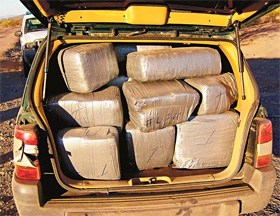 |
 |
 |
 News from Around the Americas | December 2006 News from Around the Americas | December 2006  
Border Pot Seizures Up Sharply
 Brady McCombs - Arizona Daily Star Brady McCombs - Arizona Daily Star


| | Big pot loads are coming across the border in Arizona's remote areas. Much is seized, but no one knows how much gets through undetected. (Arizona Daily Star) |
Marijuana seizures by U.S. Border Patrol agents in the Tucson Sector appear headed to new highs for a second consecutive year.

A year after hauling in 616,534 pounds of pot to shatter the previous record set in 2005, seizures are 26 percent ahead of that pace two months into fiscal year 2007, said Tucson Sector Chief Michael Nicley.

The numbers both encourage and worry Nicley. On one hand, they show that his agents are seizing illegal drugs more effectively. On the other hand, they likely signal that more marijuana is coming across the U.S.-Mexican border in Arizona.

Marijuana seizures have been increasing in the Tucson Sector since 2002. In 2003, the sector overtook the Rio Grande Valley Sector in Texas for the most seizures along the southern border and has held the top spot since then. The 616,534 pounds seized in 2006 was more than double that of any other sector. The 131,100 pounds seized since Oct. 1 is more than the total seized in the Yuma Sector from 2003 through 2006, according to Border Patrol figures.

"The sheer amount of drugs coming in that poison going to our streets is a big concern of mine," Nicley said. "We need to do anything we can to shut that flow off from Mexico."

A wet monsoon created an ideal climate for a bumper crop of marijuana in Mexico, said Anthony Coulson, assistant special agent in charge at the Drug Enforcement Administration in Arizona. That same soggy weather made it difficult for smugglers to drive their loads across and created a backlog, he said. Drug runners are bringing across that stockpiled marijuana at the same time as the fresh weed, he said.

Yet the increased seizures don't necessarily indicate more drugs are coming into the United States. Nobody knows for sure how much marijuana is produced south of the border, Coulson said.

"We believe there is more, but there is nothing we can base that on other than the presumption that good weather produced a large crop and the fact that seizures are up," Coulson said.

It also could be an indication that the Border Patrol agents are stopping more loads, he said.

"They had more boots on the ground, and this definitely is a factor why seizures are up," Coulson said.

The amount of marijuana on Tucson streets hasn't changed, said Capt. David Neri, commander of the Counter Narcotics Alliance, which monitors drug activity in the Tucson metro area.

"Most of what comes through that border is headed for other places in the United States," Neri said.

Marijuana seizures at the land ports of entry along the Arizona border haven't increased either, said Roger Maier, spokesman for U.S. Customs and Border Protection. That could change, though, he said.

"As Border Patrol increases pressures between ports of entry in the desert remote areas, we have to be on guard for a potential surge in illegally activity at the legal ports of entry," Maier said.

Seizures have increased the most on the Tohono O'odham Reservation, said Jesϊs Rod-riguez, spokesman for the Tucson Sector. They are up 360 percent in the Ajo Station, which covers the western part of the reservation, and 74 percent in Casa Grande Station, which covers the eastern part of O'odham land, he said. Unlike other areas that have fences, vehicle barriers and cameras, the area remains remote and wide open.

Smugglers often run their loads north through Papago Farms, Pisinimo and Gu Vo on their way to Arizona 86, Rodriguez said. Agents have made some major seizures in those areas.

On Oct. 24 near the village of Gu Vo, agents discovered more than 2 tons of marijuana jammed into a pair of abandoned pickups. On Nov. 28, again near Gu Vo, agents found more than 1,100 pounds of marijuana in 50 bundles tied to the fronts and backs of three all-terrain vehicles covered in camouflage blankets.

And that's just what they catch.

"It's not rocket science," Nicley said. "They are here because they are beating us. It's the reason you have the amount of narcotics traffic coming in. They are willing to take those losses to continue smuggling drugs in this corridor, and we need to turn that around."

His agency will never be able to stop drug smugglers from trying to get their loads across, but Nicley said he believes a mixture of fences, vehicle barriers, technology and agents can bring it under control and force it elsewhere.

Drive-throughs have decreased 98 percent in Organ Pipe Cactus National Monument, where the Border Patrol erected 25 miles of vehicle barriers. The agency has been working with the Tohono O'odham for the past year and a half to get authorization to build similar vehicle barriers along the 75 miles of international border.

"We need to make sure it's way too expensive to do business here in the Tucson Sector," Nicley said. "And we'll get there. Of that I'm confident."

Contact Brady McCombs at 573-4213 or bmccombs@azstarnet.com. | 
 | |
 |



